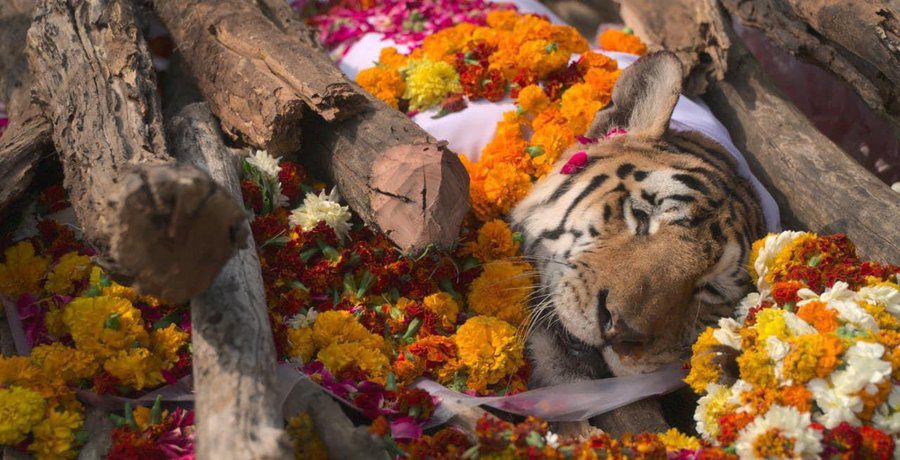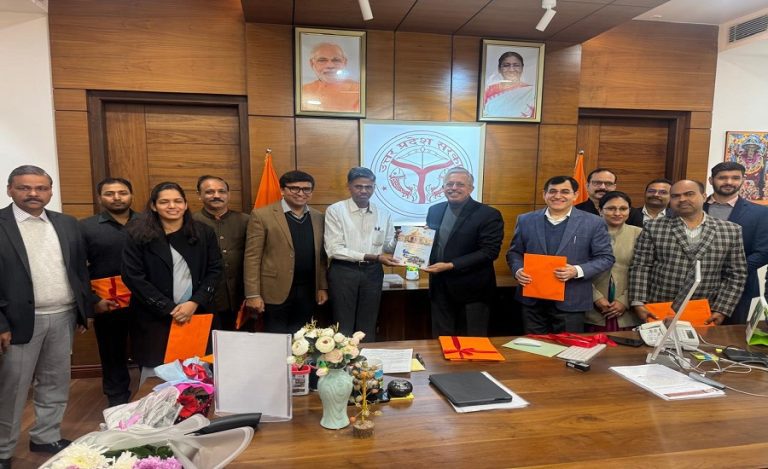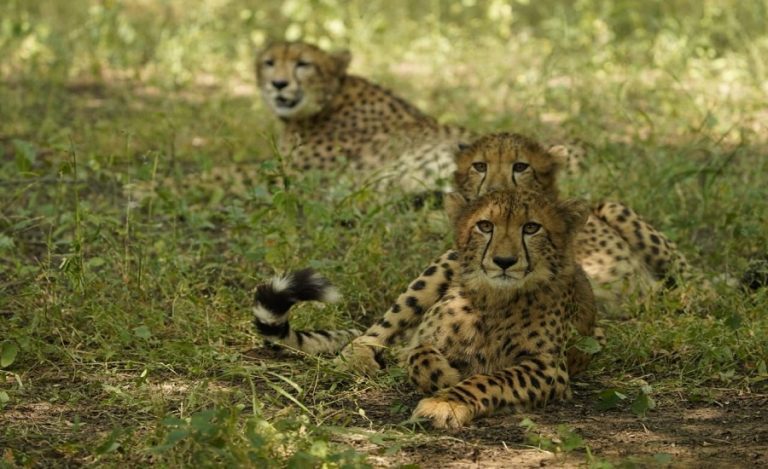She looked majestic even in her death. She was cremated with a lot of emotions. Her cremation was attended physically by over a hundred people and virtually by lakhs. Short of a gun salute and a tri-color, it was a state funeral. After all, T-15 commonly known as Collarwali was a tigress that ruled a part of Pench Tiger Reserve in Madhya Pradesh like a queen. BBC had made a documentary ‘Spy in the Jungle’ on her life and times. The social media was flooded with tribute messages for her. Because by the time she died, she had sired 29 offsprings in eight litters, a world record for a tigress, earning her the sobriquet ‘Supermom’.
Someone even posted a video said to be of the last hours before her death. The accompanying message described her last moments. “SHE CAME to the stream and was so weak that she could barely walk. She lay down near the water and did not move for two hours, with only her ears twitching. At that point, there were 42 vehicles inside Pench, and all of them spotted her.”
In one of her last spotting, T-15 had come out to drink water from an open stream on Jan 14 & had grown so weak that she walked with difficulty, lay there without moving for an hour before she was taken in by forest officials for treatment & monitoring.
— Iram Siddique (@Scribbly_Scribe) January 16, 2022
Video credit: Om Veer. pic.twitter.com/a2DNObwFGb
Within hours of this, forest officials reached the site, closed the roads, and took her in for treatment. The next evening, around 6.15 pm, the first-ever tigress to be collared at Pench breathed her last. Indian Masterminds spoke to a number of wildlife officials and scientists to find out why Collarwali was so popular among wildlife enthusiasts.
Mr. Ashok Kumar Mishra, Field Director, Pench Tiger Reserve, said the post mortem revealed the cause of death as multiple organ failure due to intestine blockage resulting from old age. “Her intestine was blocked with mud and hair,” he said. Her popularity was next only to T-16 also called Machhli, the Queen of Rajasthan’s Ranthambhor Tiger Reserve, who also passed away a couple of years ago due to old age.

Dr. Aniruddha Majumdar, a scientist with the State Forest Research Institute, who tracked Collarwali for seven years to study breeding and cub-raising among tigers, described her as “the pride of entire Madhya Pradesh”.
According to officials, T-15 was born on September 22, 2005, to T-1, also known as “Charger”, and T-7 or “Badi Mata”, another famous tigress of Pench. She was the firstborn of four cubs, and all of them were featured, along with the mother, in the documentary. Collarwali dominated the prey-rich area of the reserve and held the distinguished record of giving birth to five cubs in a litter in October 2010. It is rare for a tigress to give birth to five cubs at one go.
पेंच नेशनल पार्क की #कालरवाली_बाघिन ने सत्रह साल में 29 शावकों को जन्म दिया था.
— Awanish Sharan 🇮🇳 (@AwanishSharan) January 17, 2022
पार्क प्रबंधन की तरफ़ से श्रद्धांजलि. pic.twitter.com/BS5gkIBRA9
The popular tigress, which was fitted with the radio collar by experts from Wildlife Institute of India, Dehradun, in March 2008, was a prime attraction in the 2010 BBC Earth documentary ‘Tiger-Spy in The Jungle.’
In 2008, when Panna Tiger Reserve in MP became tiger-less, it was one of the female cubs of Collarwali only, which was sent to Panna for reviving the big cat’s population there.
The Queen of Pench Tiger Reserve, Collar wali Tigress is no more. She was one among the few iconic tigers in our country. In 16 years, she had 8 litters & 29 cubs which helped Pench gain it's glory. She was given a good farewell by the team. pic.twitter.com/orUUzsmL1Z
— Sudha Ramen 🇮🇳 (@SudhaRamenIFS) January 16, 2022
Elaborating, Pench Tiger Reserve Field Director Subranjan Sen points out that while T15 would need to hunt largely for herself — approximately a cheetal a week — till the cubs are about three months old, as they grow, her job would become harder. By the time the four cubs are 1.5 years old, Sen says, T15 would need to kill one or even two cheetals a day. No mean feat for a 12-year-old.
Wildlife scientist Ulhas Karanth, who has spent over three decades monitoring tigers, says, “A tigress acquires a territory around three years of age, holds it for 8-10 years. She raises three-four litters (say, 12-16 cubs) to a dispersal age of 18 months, that is, one litter every three years. And she lives to 10-14 years.”
Last rites of tigress Collarwali of Pench. Where else you will find such view other than India !! pic.twitter.com/w1Q6STu793
— Parveen Kaswan, IFS (@ParveenKaswan) January 17, 2022
There are other tigresses known for their many litters, including as many as six. Mai, the grand old tigress of Maharashtra’s Navegaon-Nagzira Tiger Reserve, had six before she died last year at the age of 17 in a fight with a gaur, mothering about 12 cubs. Jai, whose marathon 120-km walk from Navegaon-Nagzira to Umred-Karhandla for a mate, was one of the two cubs from Mai’s last litter. Chandi, a 10-year-old matriarch of Umred-Karhandla, is expecting her sixth litter any time now. So far, she has mothered 18 cubs, but not all have survived.

































